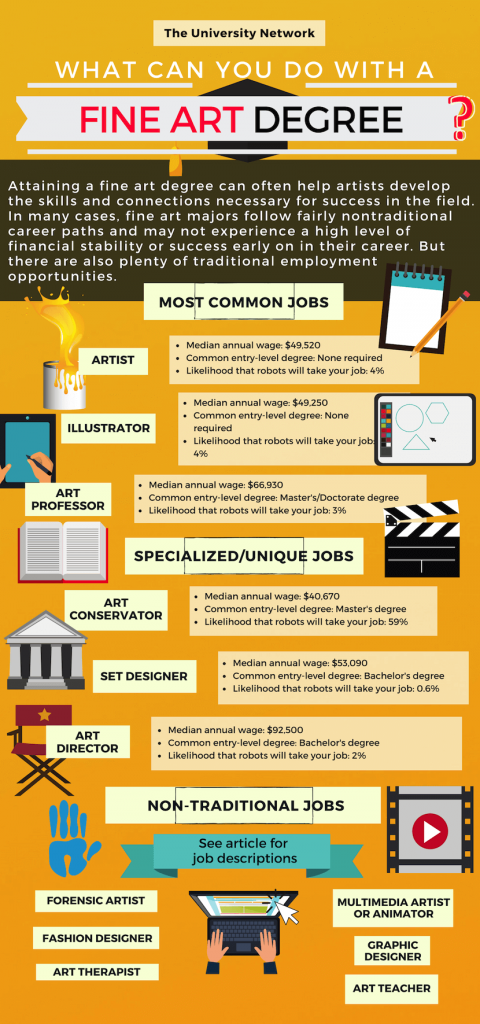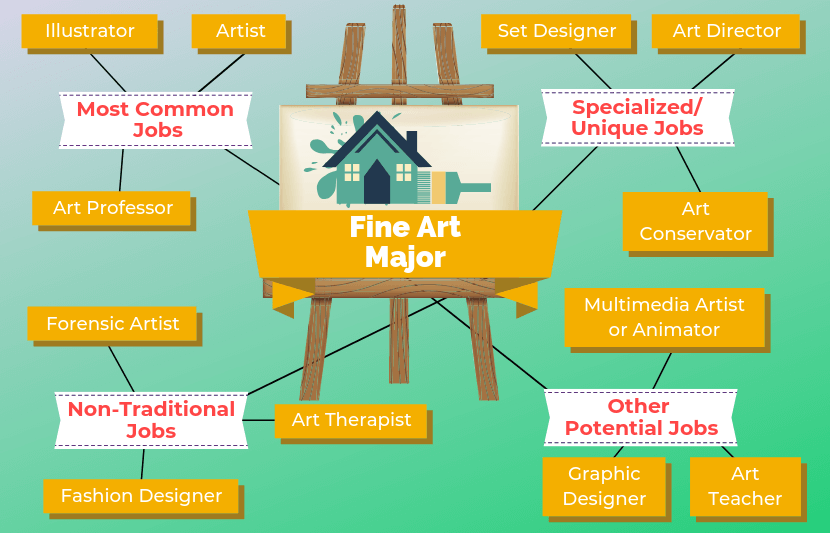Despite the stereotype of the starving artist, a career in the arts is in fact highly attainable, and attaining a fine art degree can often help artists develop the skills and connections necessary for success in the field. In many cases, fine art majors follow fairly nontraditional career paths and may not experience a high level of financial stability or success early on in their career. But there are also plenty of traditional employment opportunities.
Here is a list of 12 jobs for fine art majors:
Most Common Jobs for Fine Art Majors
1. Artist
Count this one under obvious. Most people go to art school with the goal of becoming a full-time artist and exhibiting their work in galleries, museums and other venues. Artists are typically self-employed or are represented by a gallery that helps promote and sell their work. Most of their money comes from sales of their work or from commissions on large-scale, public and permanent works. Many artists also seek grant funding for their projects. In general, artists enjoy a great deal of creative autonomy, and may work with a variety of mediums. Financial stability can be hard to come by, however, and plenty of artists are forced to find additional employment or sources of income. There is no educational requirement to be a fine artist, but attending art school can be a great way for artists to develop their skills and build valuable connections before entering the art world. It can also provide a path to other careers down the road.
Median annual wage: $49,520
Common entry-level degree: None required
Likelihood that robots will take your job: 4%
2. Illustrator
Illustrators are hired in a variety of industries to produce drawings and images. Typically self-employed, illustrators are often hired as freelance workers by publishing companies, magazines, marketing agencies, film companies, or clothing companies. They may create images for advertisements, storyboards for TV shows and movies, or covers for magazines. Illustrators may also be hired to create technical illustrations for textbooks or manuals. Some illustrators with a strong interest and background in anatomy and biology work for hospitals, medical schools, or research organizations as medical illustrators. With the advent of digital illustration, illustrators must have a familiarity with computer-aided design software, such as Illustrator or InDesign, in addition to manual illustration skills. Most illustrators find new jobs or employment through establishing contacts in their industry and building up a strong portfolio of work. There is no educational requirement to become an illustrator, but a fine arts degree can help aspiring illustrators develop their technical skills and industry contacts.
Median annual wage: $49,520
Common entry-level degree: None required
Likelihood that robots will take your job: 4%
3. Art Professor
It’s not uncommon for arts graduates to pursue careers in higher education. For many artists, teaching provides the best of both worlds, so to speak, offering both financial stability and a creative outlet. Art professors spend the majority of their time teaching or working with students while class is in session, but are also afforded studio time to work on their art and advance their careers. Universities typically hire art professors who have at least a master’s degree in art as well as a strong portfolio of work or some degree of notoriety or success within the art world.
Median annual wage: $66,930
Common entry-level degree: Master’s/Doctorate degree
Likelihood that robots will take your job: 3%

Specialized/Unique Jobs for Fine Art Majors
4. Art Conservator
Art conservators are experts in the restoration and preservation of works of art. Typically employed by a museum or a gallery, they may also work for an art conservation firm or work freelance. Art conservators must be proficient in both art and science, and should have a working knowledge of art history. Art conservators who specialize in the preservation of a specific kind of artwork (sculpture or painting, for example) should also be skilled in working with and producing art in the medium they specialize in. Art conservators must have a master’s degree in art conservation. Art conservation programs typically combine coursework in studio art, conservation techniques, and science. After obtaining a master’s degree, art conservators often then complete a fellowship program, which may last 1-4 years.
Median annual wage: $40,670
Common entry-level degree: Master’s degree
Likelihood that robots will take your job: 59%
5. Set Designer
Set designers are hired to design and produce sets for films, television shows, and theater productions. Set designers work closely with all members of a production’s visual staff — the director, cinematographer, art director, animators, costume designers, and others — to develop appealing sets that inform the production’s visual aesthetic. Fine arts majors who have strong sculpture and installation skills are particularly well-suited for jobs as set designers. While there is no formal education requirement, a fine arts degree can help aspiring set designers find first-time employment. Inexperienced set designers may also have to do unpaid work and job shadowing to break into the field initially.
Median annual wage: $53,090
Common entry-level degree: Bachelor’s degree
Likelihood that robots will take your job: 0.6%
6. Art Director
Art directors work for a wide variety of different organizations and companies as the directors of their visual style and overall aesthetics. Art directors are frequently employed in: publishing, where they design the layout, cover and visuals of a magazine or book; advertising, where they design the visual components of advertising campaigns; film or television production, where they manage set and costume designs, the color department, and other visual aspects of the production; and most other fields of media and culture. Art directors typically work their way up from lower-level positions in their field. For example, art directors in advertising may have previously been graphic designers, while art directors in film may have previously been set designers. It is possible to become an art director with a bachelor’s degree and requisite experience, though some art directors have master’s degrees.
Median annual wage: $92,500
Common entry-level degree: Bachelor’s degree
Likelihood that robots will take your job: 2%
Non-Traditional Jobs for Fine Art Majors
7. Forensic Artist
Forensic artists assist law enforcement by producing drawings and computer-generated images of crime scenes, victims, or suspects. Typically employed by law enforcement agencies or investigative firms, forensic artists are well-trained in reconstructing crime scenes and witness descriptions of criminals. Because of the irregular nature of the work, they may work on-call for a number of different agencies. Like many law enforcement officers and forensics workers, forensic artists must be prepared to report to crime scenes on short notice. Forensic artists must be capable artists, but they also must be trained in law enforcement procedures and principles of criminal justice. Many forensic artists come not from a strictly artistic background but out of other areas of law enforcement. As a result, aspiring forensic artists may want to pursue additional degrees in criminal justice or attend a police academy.
Median annual wage: $49,520
Common entry-level degree: Bachelor’s degree / Police academy training
Likelihood that robots will take your job: 4%
8. Fashion Designer
A fine art major can be a strong entry point to a career in fashion design. Fashion designers conceptualize and develop designs for clothing, footwear and accessories. They may develop original designs or adapt designs from trends. In either case, they typically create sketches of designs, select fabrics and colors, and work with other designers and artists to create prototype designs. They typically use computer-aided design software to further develop sketches before creating prototypes, so aspiring fashion designers should have some familiarity with these programs. They also work with management or artistic directors to devise themes for collections and create designs to match the theme. A bachelor’s degree in fine arts can serve as an entry point into a career in fashion, but aspiring fashion designers might want to consider pursuing a degree specifically in fashion design.
Median annual wage: $67,420
Common entry-level degree: Bachelor’s degree
Likelihood that robots will take your job: 2%
9. Art Therapist
Art therapists are trained professionals who work with a variety of clients and patients, using art activities to improve their overall well-being or provide relief or recover from personal challenges, illnesses or injuries. Art therapists may work in a number of settings, including schools, where they work with children with special needs, hospitals where they work with patients, and community centers. As a result, art therapists must be capable of working with a wide variety of individuals with unique challenges. Art therapists also may not be employed under the title of “art therapist” but in community and counseling jobs with various other titles. In order to become an art therapist, you will need to earn a bachelor’s degree in art or psychology and a master’s degree in art therapy. You will then need to complete an internship where you work firsthand with patients, and become licensed in the state you intend to practice in.
Median annual wage: $47,680
Common entry-level degree: Master’s degree and license
Likelihood that robots will take your job: 0.3%
Other Jobs for Fine Art Majors
10. Multimedia Artist or Animator
Artists who have a proficiency in animation and computer graphics might consider working as a multimedia artist or animator. Multimedia artists develop graphics, designs and visual effects for television, movies, video games, websites and other kinds of media. This is a burgeoning and relatively high-paying career within the arts that is expected to continue to grow with increasing demand for computer-generated imagery. A bachelor’s degree in fine art is a great stepping stone to a career in this field, but fine arts majors will need to develop and demonstrate computer graphics and multimedia design skills. When considering applicants, employers look first and foremost for a strong portfolio of work, which you may develop in classes, by working freelance, or on your own time.
Median annual wage: $70,530
Common entry-level degree: Bachelor’s degree
Likelihood that robots will take your job: 1.5%
11. Graphic Designer
It is not uncommon to find artists working as graphic designers, applying their artistic abilities and knowledge of design to commercial products, advertisements, books, and more. Graphic designers may work as self-employed freelancers or for a design firm. Others are employed by advertising agencies or by companies with an in-house design department. Graphic designers need strong illustration skills and a proficiency in digital illustration, photo-editing and layout softwares. Graphic designers typically need a degree in art or graphic design, as well as a strong portfolio that demonstrates their ability.
Median annual wage: $48,700
Common entry-level degree: Bachelor’s degree
Likelihood that robots will take your job: 8%
12. Art Teacher
A fine art major who loves working with kids and young adults should seriously consider becoming a high school art teacher. More than a fallback option, teachers have among the most rewarding and engaging careers. As a teacher, you can communicate and hopefully pass down your passion to the next generation and significantly impact the lives of your students for the better. To become a school teacher, you will need to graduate with a bachelor’s degree in the subject you want to teach, while completing your school’s teacher preparation program. You’ll then need to complete a teaching internship in your subject, take and pass your state’s teaching licensure tests, and get your teaching license. Prospective teachers should consider majoring, or pursuing a master’s degree, in art education.
Median annual wage: $59,130
Common entry-level degree: Bachelor’s degree
Likelihood that robots will take your job: 0.8%
10 Famous People Who Studied Fine Art
- Nick Cave, musician
- Paul Chan, artist
- Kim Gordon, musician
- Abbi Jacobson, actress and comedian
- Joan Jonas, artist
- Jeff Koons, artist
- Jemima Kirke, actress
- John Lennon, musician
- Seth McFarlane, animator and comedian
- Richard Serra, artist
To explore options for other majors, click here.



